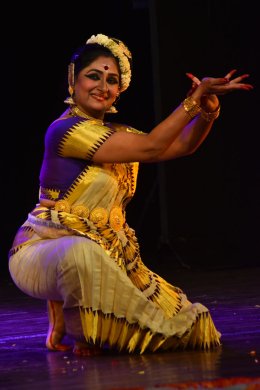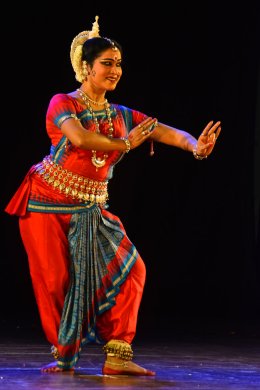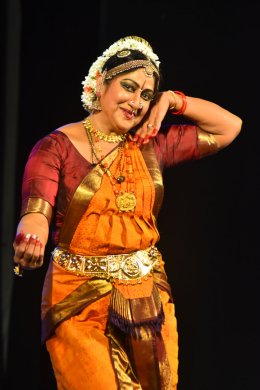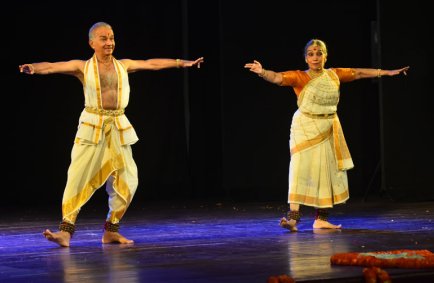
|   |

|   |
 e-mail: sunilkothari1933@gmail.com A magical evening September 26, 2017 After a few years if the dance aficionados were to discuss and recollect the arrival of Sunanda Nair from USA where Houston was submerged in water, to perform for Sai Nrityotsava 100 on September 1, 2017 in Bangalore, they would not believe that she had made it on time to perform at JSS Rangamandira, without showing slightest sign of jetlag! To put it in terms of mythological context, it would not be an exaggeration to say that some very special guiding angel, must have flown her across the ocean and placed her invisible to the eyes of the mortals, in the green room. For, when she arrived in her full Mohiniattam regalia she was a Mohini, enchantress, who mesmerized the audience. She was ushered into the auditorium with a resplendent royal red umbrella over her head with the hosts Sai Venkatesh and his wife Suparna and other retinue members following her with fanfare! That was dramatic enough to set the celebrations for the 100th evening of dance performances. Never-say- die Sai Venkatesh had started presenting on the first of each month, young up and coming dancers. That was for eight years and four months. And during this time he never missed any date. For the record, months ago he had planned the 100th dance as a gala event inviting four senior dancers like Sunanda Nair from Houston for Mohiniattam, Sujata Mohapatra for Odissi from Bhubaneswar, Manju Bhargavi for Kuchipudi from Bangalore and Dhananjayan and Shantha for Bharatanatyam from Chennai. Along with this Sai also planned a conference of organizers. These voluntary organizers have been promoting young dancers for the past ten years. In Vishakapatanam, Vikram Bathina Goud has been arranging annual dance festival Vaishakhotsava in month of September and Satyabhama Kuchipudi dance festival. In Bhubaneswar, Jagabandhu Jena has been organizing Mahari Dance Festival to promote and preserve Mahari dance tradition of Odisha. In Chennai, Churchill Pandian organizes a few festivals promoting young dancers. This voluntary work has been recognized by artists. Such work poses several problems for raising funds. In Bangalore, Veena Murthy Vijay is involved with organizing several national and international festivals. She has vast experience of organization and also understanding of raising funds. Another enthusiastic Bharatanatyam performer and organizer, Kashmira from Thane, also attended the organizers' meet. Sai had made arrangements for meeting at Apurva Restaurant opposite JSS Auditorium - an unusual restaurant, where people can sit on the floor, also have special lunch minus onions and garlic. Simple, sattvik food has become very popular. For celebrations of Sai Nrityotsava 100, Helen Acharya, former Secretary of Sangeet Natak Akademi, was invited to inaugurate the festival. She gave very useful suggestions to the organizers, as she has vast experience for more than 30 years of organizing festivals for SNA. The performance began with Purvarangam with three energetic young male dancers Soma Shekhar, Sharath TS, and Nidhaga Karunad, who with their electrifying entry and movements kept audience in thrall. Suparna Sai had choreographed the dance as per the dictates of the Natyasastra. The purification of the stage, the placing of the jarjar dhwaja and worship of presiding deities of the eight directions was well performed. The tandava, the vigorous dance of these three dancers was most impressive. Then followed the Kaishiki dance by four young dancers: Kavyashree Nagaraj, Kshamitha Shastry, Ashitha R Kumar and Swetha Venkatesh, who with their graceful and alluring dancing provided quite a contrast to tandava. The choreography was imaginative capturing the essence of Kaishiki vritti mentioned in the Natyasastra. Then followed the performances by the senior dancers. Sunanda chose to dance Vallabhacharya's Madhurashtakam, enriching it with sancharis, episodes from life of Lord Krishna. The most touching was the visit of Sudama to Dwaraka to see his childhood friend Krishna. He had only brought rice as a gift for Krishna and was embarrassed after witnessing the splendor of Dwaraka, the palace, and the opulence all over. Krishna welcomed him with great affection and washed his feet, asked his wives to fan his childhood friend, and took away from Sudama, the rice he had brought. He ate a mouthful of it and Sudama's old hut turned into a palace and wife and children had new clothes and ornaments. On returning Sudama found his old hut had disappeared and so were his ill fortunes! The sakhyam, friendship of Krishna is full of madhuryam and it was enacted by Sunanda in a very touching manner. Shikhandi's revenge was the second number which has become Sunanda's signature piece. Bhishma's rejection of Amba, the humiliation, parihas, the agony et al of Amba, were enacted with netrabhinaya and mukhajabhinaya in an eloquent manner.  Sunanda Nair  Sujata Mohapatra Sujata Mohapatra with her incomparable Odissi, reflecting the fundamental, sound training under Guru Kelucharan Mohapatra also cast a spell. There is an aura about Sujata. Her Yugma Dwandwa in melodious Bagesri raga and eka tali composed by Pandit Raghunath Panigrahi was a tour de force. It indeed evoked memories of Sanjukta Panigrahi and Raghunath Panigrahi's jugalbandi. Sujata has excellent command over tala and laya and she loses her 'self' while performing, delighting the audience. The nritta with her chiseled figure acquired another extra dimension. The jugalbandi, the repartee with the musician, matching the solfa notes, swaras, was fascinating. Both nritta and music became equal partners. The dancing on the heels, sculpting the various poses, like parshva maradala or darpani, karihasta, embellished the pallavi. For abhinaya, Sujata chose Guru Ratikant Mohapatra's choreography of Shabari from Ramayana, to the chaupais of Tulsidas. The delineation of abhinaya for the character of old Shabari, waiting for the darshan of Lord Rama was full of intensity. Offering Lord Rama the berries after tasting them, with hand atremble, was enacted with complete feeling of surrender. Tulsidas's chaupais were transformed to depict the character of Shabari as a devotee in a delectable manner. Gifted as she is, Sujata succeeded both in enjoyable nritta and abhinaya. Rupak Kumar Parida's singing and mardala by Ratikant Mohapatra were excellent.  Manju Bhargavi
Manju Bhargavi, a senior disciple of Vempati Chinna Satyam, became well known with her appearance in film Shankarabharanam. Performing in several dance dramas choreographed by Vempati, she often was cast in the role of Lord Vishnu with her majestic personality. However she was adept both in solo and roles offered in dance dramas. She presented excerpts from Bhamakalapam with patrapravesha daru of Satyabhama. As proudha, garvita, swadhinapatika nayika, she did justice to the role of Satyabhama, as patralekha with padarthabhinaya, depicting each word with hastas and appropriate expressions. Right from shrimad ratnakaraputrika mukharvind till last signing of her name as Satya, it was a moving display of a repentant nayika, begging forgiveness of her Lord and begging him to come unto her. Rendered in Shankarabharanam raga, it brought out Satyabhama's agony. Shakunalu, the auspicious omens in raga Arabhi displayed her joy. Satyabhama was delighted that her sending letter was bound to result in success and she would be reunited with Lord Krishna. Vempati's choreography for these sequences is evergreen and evokes feelings of admiration for his genius. The javali Parulana mata of Dharmapuri in Kapi raga, begging the nayaka not to listen to the other woman, gave Manju scope to depict the wiles of the other woman who would not stop at anything to entice him. She would mix intoxicants in the drink that she would offer whereby he would be drawn to her. The expressions were so graphic that one's sympathies seemed to be on the side of the helpless nayika. Dhananjayan and Shantha, dressed in simple costume becoming their age, endeared themselves to the audience. Dhananjayan's disciple in Bangalore, Kiran Subramaniam conducted the nattuvangam and the honey voiced Priti Mahesh from Chennai sang soulfully. Vineet was on mridangam and Kalaiarasan accompanied on violin. After Mallari, Shantha and Dhananjayan performed prayer in praise of Ganesha, almost deconstructing the song and alternatively dancing with epithets of the lord as Modaka hasta, Mushikavahana which looked interesting as their lifelong tapasya for dance has brought to them such maturity and dignity. Shantha performed sitting on a small stool, Jayadeva's ashtapadi Sancharadhara, depicting Radha's state of jealousy seeing Krishna playing Rasalila with other Gopis. The exquisite similes for Krishna's beauty, chandrakacharu, attractive like moon, dhanur purandara, the eyebrows like the bow of Indra, and his playing Rasalila with stanzas vallabhayuvati sahsram, countless Gopis, came alive with adequate abhinaya.  Dhananjayan and Shantha
The finale by Dhananjayan was abhinaya to Papanasam Sivan's song in which even gods ask Yashoda about what punya she has earned, that the Lord of the three worlds is playing as a child before her. Even Brahma is jealous, O Amma Yashoda, tell us how Lord Vishnu has become your child! Dhananjayan turned into mother Yashoda, took child Krishna for bath, Krishna had stanapana, when mother Yashoda took him to breastfeed. Dhananjayan's abhinaya for that passage was instantly applauded by the audience. When mother Yashoda placed Krishna in the cradle to sleep and turns to leave him, naughty Krishna came out of the cradle and pulled Yashoda's pallu. Yashoda displayed her anger but was overcome with love. Dhananjayan's transforming into mother Yashoda was exquisite and one marvelled at his ability to transcend gender. The audience, in particular, the young generation, was hysterical with joy watching it and cheered loudly. The song further describes that Brahma, Sanaka, Indra and others crave for a glimpse of him. As all these gods question Yashoda, she fondles the child Krishna lovingly. The abhinaya by Dhananjayan was so unalloyed, refreshing, endearing that it resulted into rasanubhuti, aesthetic delight. Shantha performed a javali depicting khandita nayika dismissing the culprit nayaka with suchi hasta and closed the doors on him. The brevity of the song and abhinaya were enticing, and brought out the essence of javali and the mood. When in the end for Mangalam both performed together offering the idol, garland and folded hands to audience, the audience gave them standing ovation for a long time. Indeed, it was a moving recital by both of them. When I say it was a magical evening, I am not exaggerating. After the show concluded, no one seemed to be in a mood to leave. Sai Venkatesh, Suparna, and the entire team deserve compliments for a memorable Sai Nrityotsav 100. There was palpable excitement in the air and one would remember the evening for a long time.  Dr. Sunil Kothari is a dance historian, scholar, author and critic, Padma Shri awardee and fellow, Sangeet Natak Akademi. Dance Critics' Association, New York, has honoured him with Lifetime Achievement award. Post your comments Please provide your name and email id when you use the Anonymous profile in the blog to post a comment. All appropriate comments posted with name & email id in the blog will also be featured in the site. |